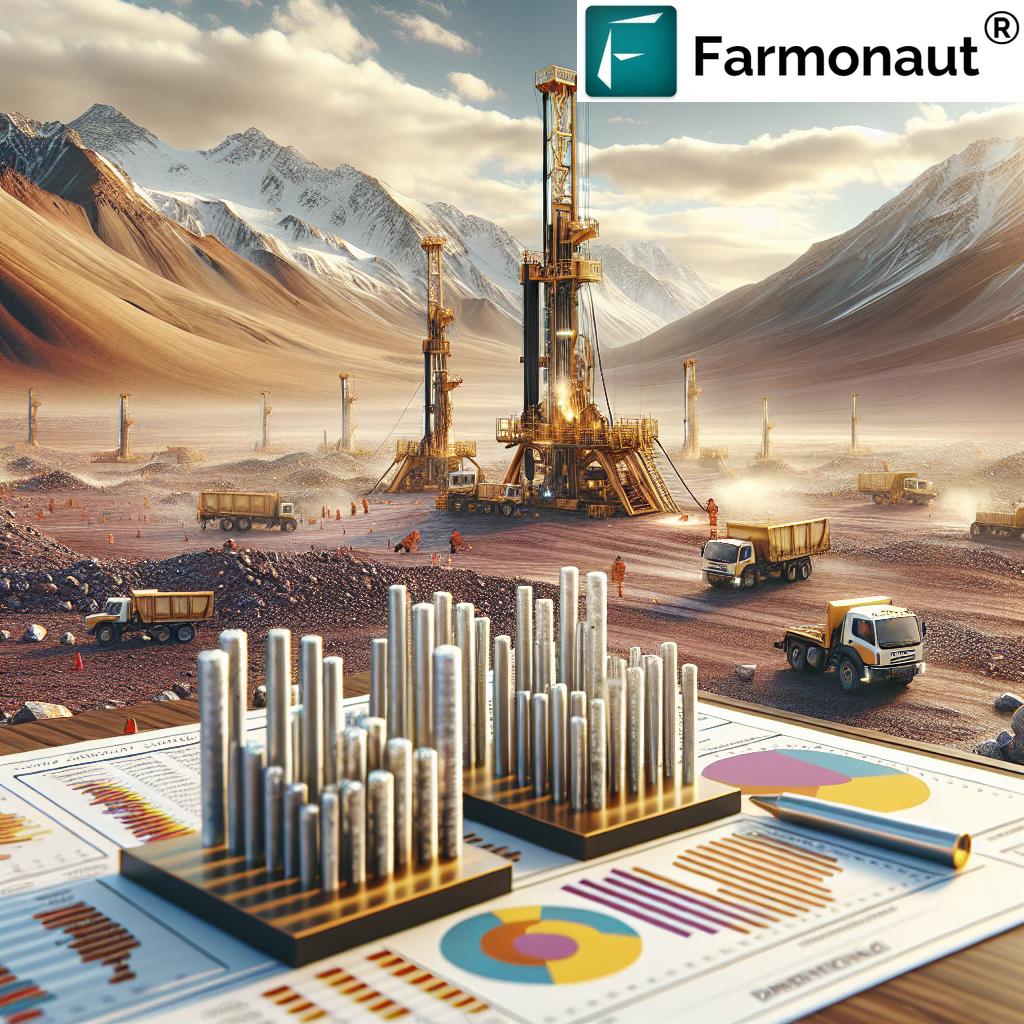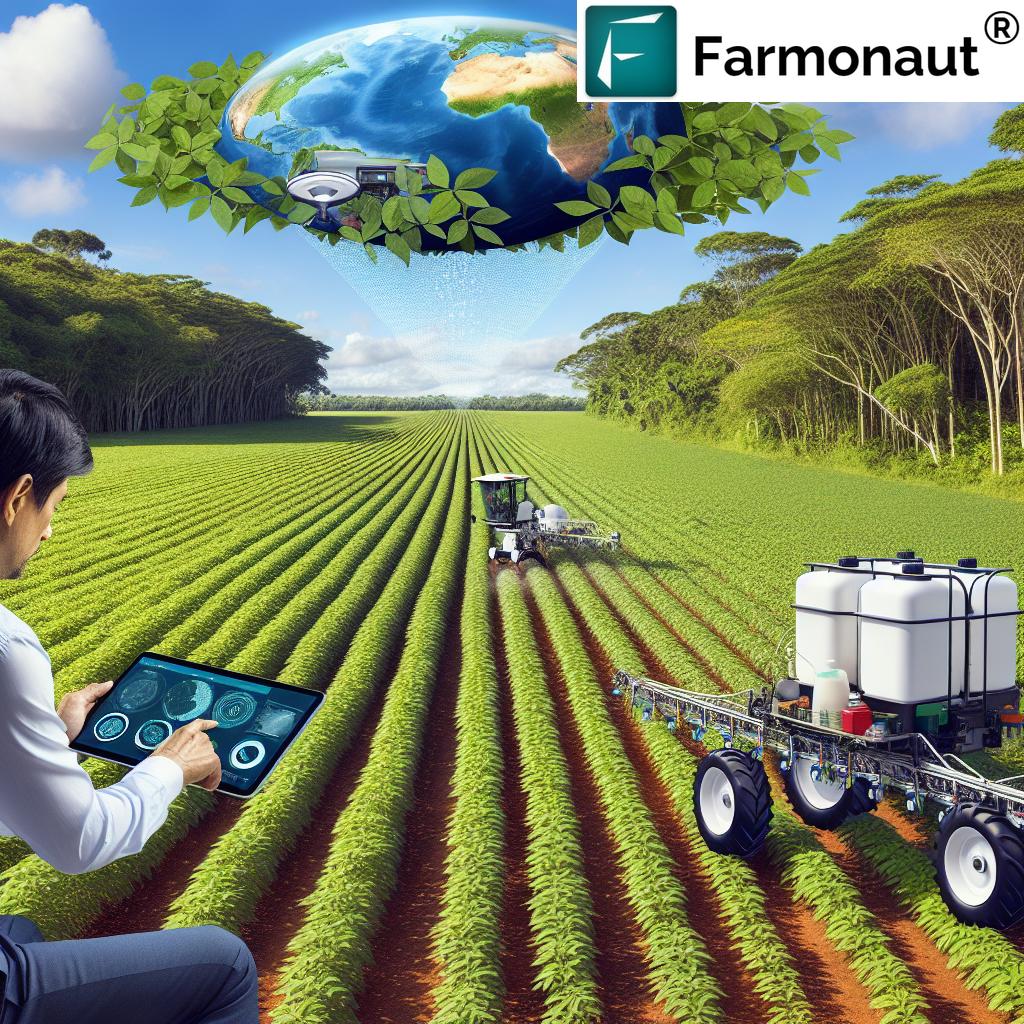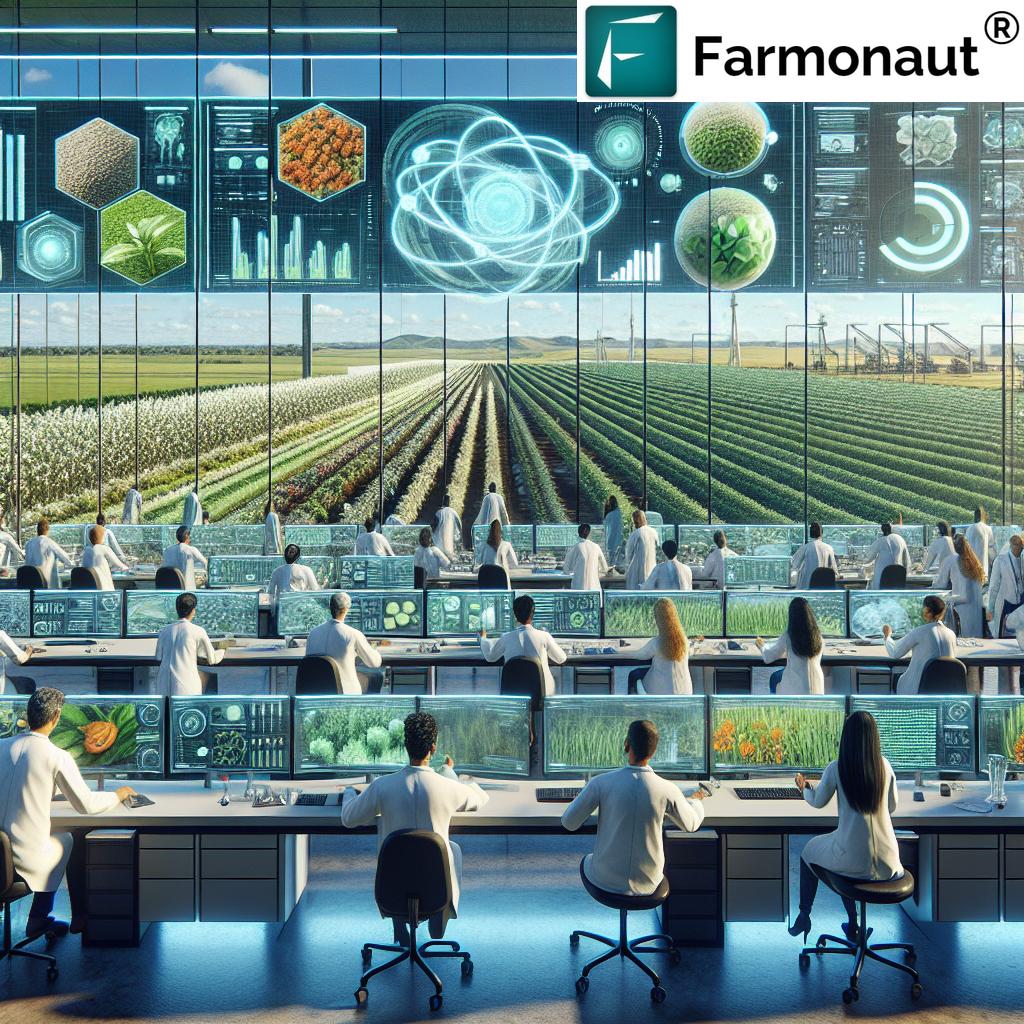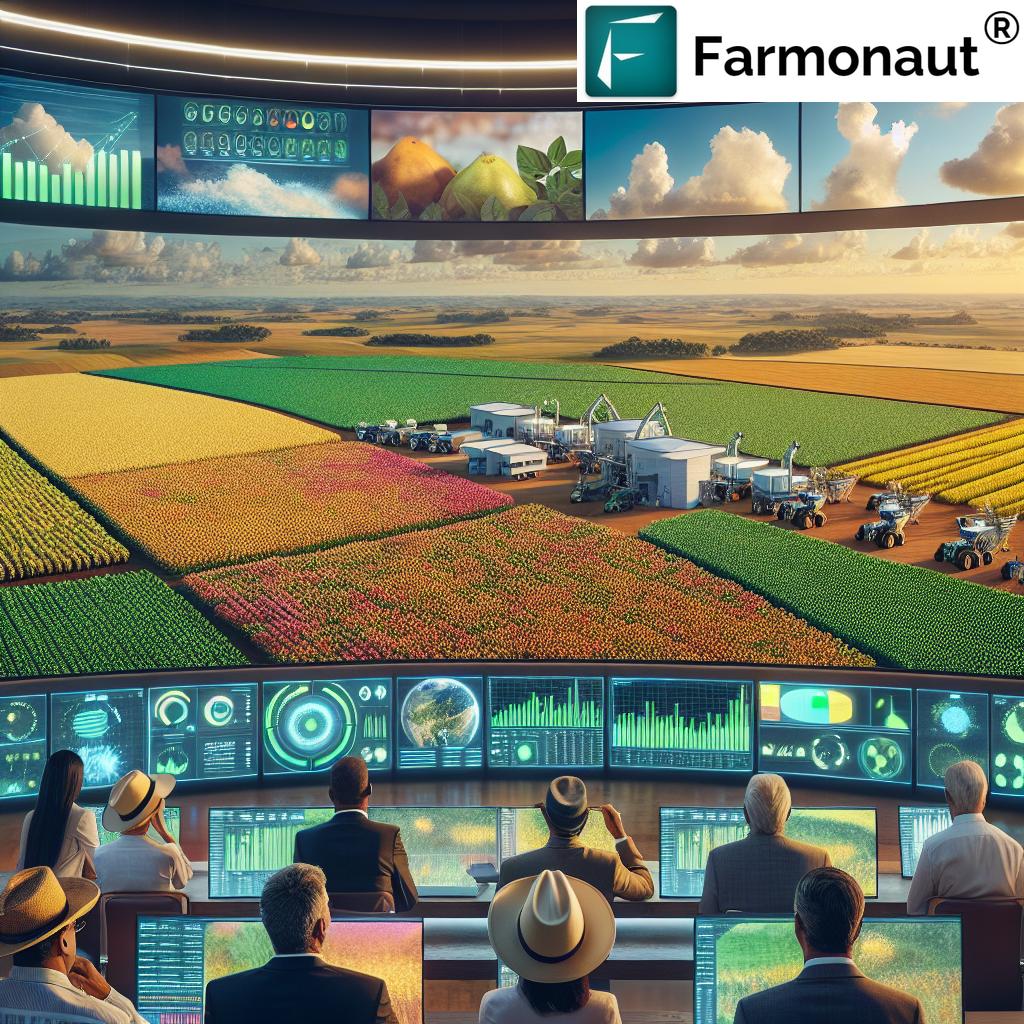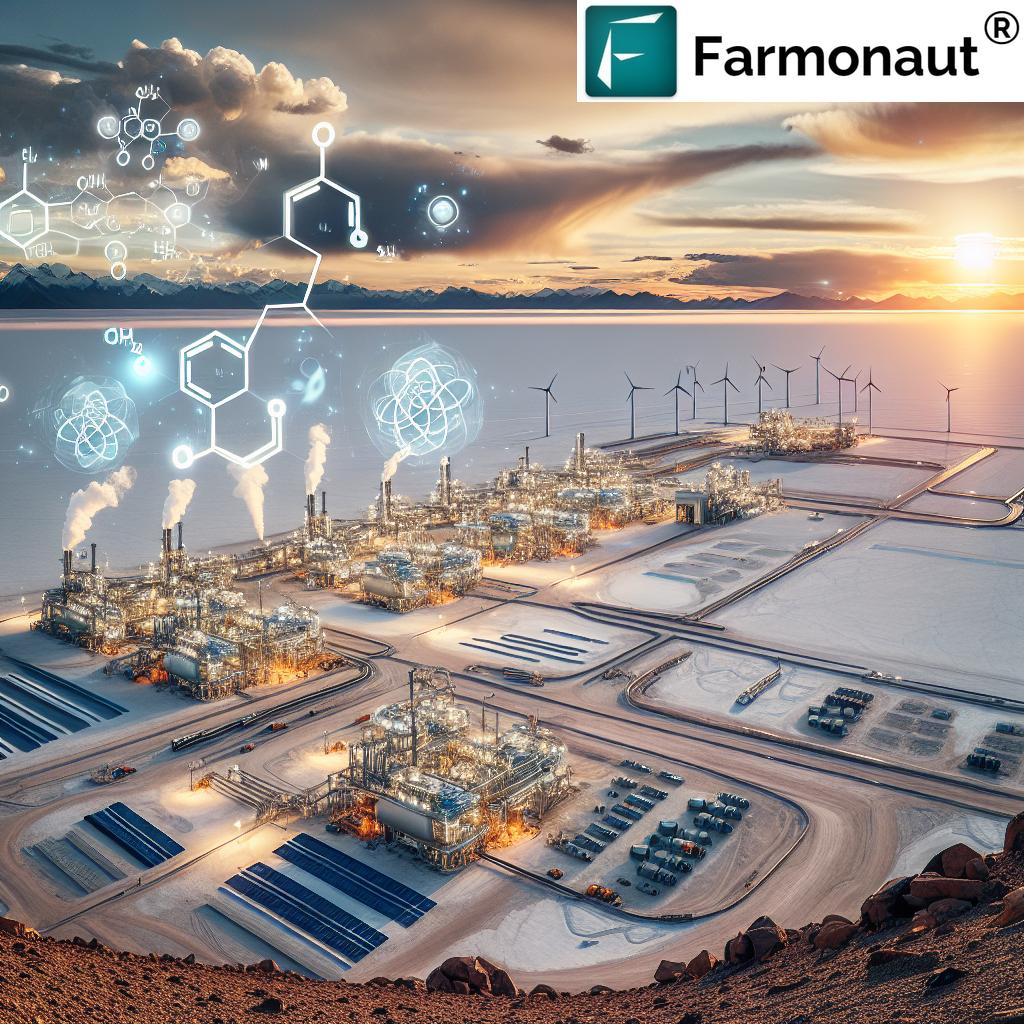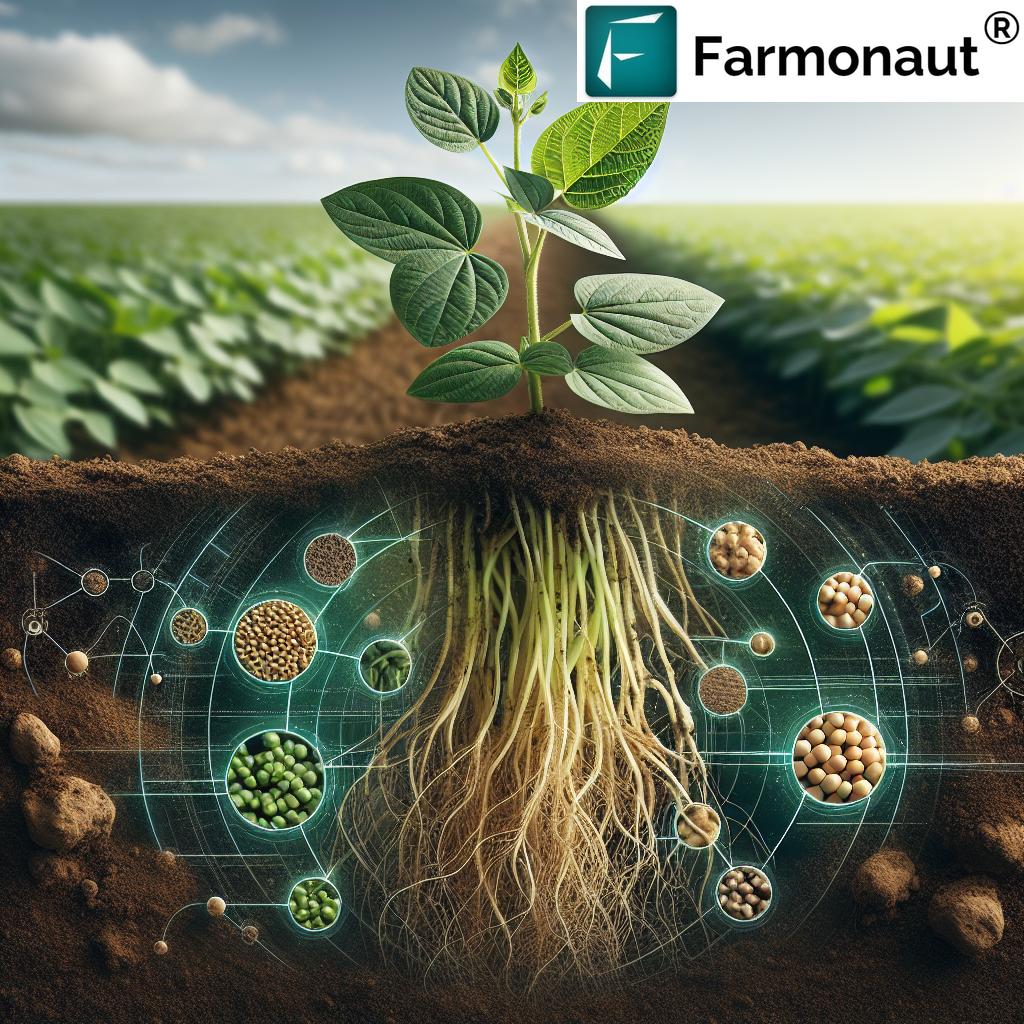Climate Forecasting & AI: Brazil 2024 Soybean Yield Insights
“AI-driven climate forecasting improved Brazil’s 2024 soybean yield predictions by up to 15% compared to traditional methods.”
- Introduction
- The Importance of Climate Forecasting in Agriculture
- Brazil Soybean Production 2024: A Case Study in Climate, Forecasting, and AI
- AI Weather Forecasting: Transforming Resource Allocation in Agriculture
- Integrating Climate Forecasting and Resource Allocation in Fruit Production
- Estimated Soybean Yield Improvement with AI-driven Climate Forecasting (Brazil, 2024)
- Integrating AI Predictions into Agricultural Management Practices
- Farmonaut: AI, Satellite, and Blockchain Innovations for Smarter Farming
- Looking Ahead: 2025 and Beyond for Climate Forecasting and Resource Optimization
- Frequently Asked Questions
- Conclusion
Introduction
In the modern agriculture landscape, the ability to anticipate weather and climate fluctuations has never been more crucial. As we move through to 2025, climate forecasting and resource allocation in fruit production—particularly when empowered by AI weather forecasting—are revolutionizing how farmers and decision-makers respond to climatic uncertainties. This progress is not just visible in global agri-business but is especially profound within Brazil’s enormous soybean industry, where strategic use of advanced forecasts have helped to optimize irrigation, reduce resource losses, and significantly improve yield and crop quality.
In this article, we explore the profound impact of AI-empowered weather prediction on farming in Brazil, focusing on the brazil soybean production 2024 forecast as a lens to understand broader industry transformation. We’ll also shed light on the critical role of climate forecasting, advancements in AI-driven agritech, and how these tools are being integrated into management systems to enhance productivity, sustainability and resilience across agricultural sectors for 2025 and beyond.
The Importance of Climate Forecasting in Agriculture
Climate forecasting lies at the heart of modern agriculture. Agricultural success is intricately dependent on weather variables—temperature, precipitation, humidity, and extreme events directly influence yields, resource allocation, and crop quality. With escalating climate variability and new patterns in rainfall and temperature, the need for effective climate and weather forecasting has become indispensable for mitigating risk and optimizing inputs within fruit production as well as soybean and other broadacre crop cultivation.
How Weather Influences Agricultural Decisions
- Irrigation Scheduling: Timely and data-driven forecasting helps to optimize irrigation applications based on predicted moisture needs, reducing water waste and ensuring crop health.
- Fertilization and Nutrient Management: Forecasts on rainfall and drought enable precise timing of nutrient application, improving uptake and minimizing losses due to leaching.
- Pest and Disease Risks: Certain pest outbreaks and disease events are triggered by specific weather conditions—e.g., high humidity favoring fungal infection or delayed rain fostering insect build-ups. Effective use of ai weather forecasting enables proactive intervention.
- Harvest Timing: In fruit crops, correctly forecasting climatic events (like pre-harvest storms) can prevent quality loss and maximize market value.
- Damage Prevention: Frost, heat waves, and dry spells can cause significant losses. Advanced climate prediction enables timely action such as frost protection or emergency irrigation.
For fruit producers, understanding subtle variations in weather during sensitive phenological stages—flowering, fruit set, and ripening—is essential. Inadequate timing or misallocation of resources not only leads to significant economic losses but can also compromise future productivity through soil depletion or pest resistance buildup.
Further, in soybean production, strategic adaptation based on variability in rainfall, planting windows, and temperature shifts is critical to ensuring yield resilience year-on-year.
Common Scenarios Where Forecasting is Critical
- Sudden Onset of Dry Spells: Without warning, a period of drought can reduce fruit size or lead to incomplete kernel filling in soybeans—imposing losses unless supplemental irrigation is allocated effectively.
- Late-Season Frost: In fruit crops, untimely frost may damage blooms or developing fruits, compromising both yields and quality.
- Excessive Rainfall: Leads to nutrient leaching, increased disease risk, and hampered harvest. Precise knowledge from forecasting models and AI tools can minimize negative impacts.
“Over 80% of Brazil’s large-scale fruit farms now use AI weather models for precise resource allocation and yield optimization.”
Brazil Soybean Production 2024: A Case Study in Climate, Forecasting, and AI
Brazil is one of the world’s largest soybean producers, serving as a key hub in global protein supply chains. The brazil soybean production 2024 forecast highlighted both progress and ongoing challenges linked to climate variability and weather prediction. The interplay of El Niño-induced shifts in rainfall, changing planting windows, and rising pest and disease outbreaks demanded a new level of technological intervention in resource allocation across the industry.
Regional Climate Challenges and Yield Fluctuations
- Southern Brazil (Paraná, Rio Grande do Sul): Excessive rainfall leading to soil moisture issues, plant lodging, and delayed harvests. Precise forecasting mitigated the economic impact through timely rescheduling of field operations.
- Cerrado (Mato Grosso, Goiás): Some areas experienced delayed rains, causing later planting and altered fertilizer (NPK) management strategies for maximizing nutrient uptake during critical growth stages.
- Mato Grosso do Sul and Bahia: Faced regional outbreaks of pests and diseases precipitated by moist, warm conditions. Anticipatory use of AI-based pest forecasting tools enabled cost-effective control and minimized losses.
Integrating high-precision, real-time climate forecasts empowered farmers to make data-driven decisions on resource allocation, mitigate risks of losses, and optimize yield outcomes. Historically, years with less precise forecasting tools showed greater susceptibility to losses due to misaligned irrigation scheduling, fertilizer waste, and poor timing of pest or disease interventions.
Yield Fluctuations and Resource Optimization Based on AI Forecasts
With the implementation of AI weather forecasting and climate prediction models in 2024, estimated average soybean yields were improved by 10–15% compared to projections based solely on traditional meteorological forecasting. Additionally, optimized resource allocation led to fertilizer use reduction by up to 12% and **water savings** over 18% in irrigated areas. The impact of integrating climate forecasting on resource optimization and sustainable agriculture management in Brazil cannot be overstated.
AI Weather Forecasting: Transforming Resource Allocation in Agriculture
AI weather forecasting is rapidly transforming agricultural practices worldwide—and its role in brazil soybean production 2024 forecast and fruit production has become especially prominent. Unlike traditional meteorological models, AI-powered models draw upon a multitude of data sources (e.g., historical weather patterns, high-resolution satellite imagery, in-field sensors, and real-time atmospheric data), assimilating information to generate more accurate, finely localized, and adaptive forecasts.
How Does AI Weather Forecasting Work?
- Data Aggregation: AI models integrate and analyze massive quantities of climate, weather, and soil datasets.
- Machine Learning Optimization: Algorithms refine forecasting by recognizing patterns in how historical weather events have impacted crop outcomes, dynamically learning from new data inputs.
- Microclimate Adaptation: AI’s capacity to analyze complex local variations allows it to provide farmers with highly targeted, contextually relevant predictions on rainfall, frost risk, pest/disease outbreaks, and optimal intervention timing.
- Continuous Improvement: With every growing season, AI models become smarter as they ingest more observational and sensor data, improving future performance and predictive value.
The practical benefits of ai weather forecasting for growers include:
- Anticipating and responding to climate uncertainties faster
- Increasing yield potential by syncing growing practices with forecasted weather
- Improved resource allocation to reduce losses from waste or misapplication
- Enhancing overall resilience and sustainability of agricultural systems
For example, AI-based frost prediction enables fruit farms to schedule protective irrigation and row covers efficiently, while real-time rainfall forecasts drive smarter irrigation scheduling across soy and fruit systems.
Learn more about AI and satellite integration for smarter farming in this featured video:
Integrating Climate Forecasting and Resource Allocation in Fruit Production
The synergy between climate forecasting and resource allocation in fruit production is driving greater efficiency and sustainability. By delivering precise, actionable insights into near-term and seasonal weather expectations, modern forecasting tools allow producers to deploy inputs—water, fertilizer, pesticides, labor, and equipment—with unprecedented precision. This generates cascading benefits, reducing input costs, minimizing environmental impacts, and maximizing quality and yield.
Application Scenarios for Fruit and Crop Producers
- Smart Irrigation Scheduling: Automated irrigation systems connected to AI weather forecasts adjust water use before/after predicted rain, preventing both under and over-watering.
- Nutrient Management: Fertilization timing is optimized against forecasted rainfall and temperature trends—protecting against nutrient leaching and enhancing uptake.
- Pest and Disease Forecasts: Early warnings facilitate efficient, targeted use of control products, reducing chemical inputs and safeguarding crop quality during sensitive phenological stages.
- Harvest Optimization: Combining in-field sensor data with weather forecasts determines ideal harvest windows, protecting fruit against losses from storm or heat damage.
- Sustainability Tracking: With advanced tools, growers assess their carbon footprint and adjust practices to enhance climate resilience.
Estimated Soybean Yield Improvement with AI-driven Climate Forecasting (Brazil, 2024)
| Region | Traditional Forecasted Yield (tons/ha, 2024, est.) |
AI Forecasted Yield (tons/ha, 2024, est.) |
Estimated Yield Improvement (%) | Impact on Resource Use (Water/Fertilizer Reduction, % est.) |
|---|---|---|---|---|
| Mato Grosso | 3.10 | 3.55 | ~14.5 | Water – 18%, Fertilizer – 12% |
| Paraná | 2.95 | 3.34 | ~13.2 | Water – 15%, Fertilizer – 11% |
| Rio Grande do Sul | 2.65 | 3.02 | ~14.0 | Water – 16%, Fertilizer – 10% |
| Goiás | 3.05 | 3.42 | ~12.1 | Water – 14%, Fertilizer – 9% |
| Bahia | 2.80 | 3.10 | ~10.7 | Water – 13%, Fertilizer – 8% |
Table: Regional comparison of estimated yields and resource savings as a result of AI-driven climate forecasting integrated into the 2024 Brazil soybean production cycle. AI delivers substantial improvements in both productivity and input efficiency.
Producers looking to further optimize their management can explore fleet and resource management solutions for streamlined equipment use, reducing fuel and labor costs.
Our satellite-based verification for crop loans and insurance enables financial institutions to offer better rates while reducing fraud, enhancing access to critical capital for Brazilian growers.
Integrating AI Predictions into Agricultural Management Practices
The integration of AI-based weather prediction into daily farm management unlocks numerous pathways for improved resource allocation and risk mitigation—not just in Brazilian soybeans, but across global fruit and crop systems. Here are the practical steps for leveraging next-generation forecasting tools:
- Use AI dashboards and apps (like Farmonaut) to monitor and adjust irrigation as weather forecasts shift, optimizing water use while maintaining yield.
- Adjust fertilizer blends and timing based on forecasted rainfall—cutting waste and increasing nutrient uptake during periods of ideal soil moisture.
- Deploy pest or disease control products proactively—guided by real-time alerts when weather conditions are optimal for outbreaks.
- Coordinate harvest operations to avoid predicted storms or heatwaves, protecting quality at the crucial timing of harvest.
- Utilize environmental monitoring to track yield-linked carbon emission metrics, supporting sustainability claims in markets and to regulators.
Farmonaut: AI, Satellite, and Blockchain Innovations for Smarter Farming
At Farmonaut, our mission is to make satellite, AI, and blockchain-powered insights affordable and accessible to all segments of the agriculture value chain. We empower growers, businesses, and governments to transform the way they approach climate forecasting and resource allocation in fruit production, soybean, and other crops, offering powerful, real-time monitoring, predictive, and management tools available on web, mobile, and API.
How Farmonaut Delivers Value:
- Satellite-Based Monitoring: We enable crop, vegetation, and soil health monitoring using high-res multispectral imagery for actionable insights across fruit, soybean, and broadacre systems.
- Jeevn AI Advisory System: Our AI tool analyzes satellite data, delivers real-time forecasts, and tailors strategies for agriculture, helping maximize productivity and resource efficiency.
- Blockchain Traceability: Complete blockchain-based product and resource traceability for quality assurance, market credibility, and transparent food chains.
- Fleet and Resource Management: Optimization of vehicles, equipment, and farm logistics for efficient large-scale production management.
- Environmental Impact & Sustainability Tracking: Track your farm’s carbon footprint and make data-driven adjustments for sustainability in fruit and soybean production alike.
- Scalable, Mobile-Friendly Access: Our platform and API (see developer docs) ensure insights are a click away—whether you manage one field, thousands of hectares, or national policy.
- End-to-End Large-Scale Farm Management: For bigger operations, explore large-scale farm management tools for unparalleled oversight and efficiency.
Ready to enhance your productivity with world-class AI-powered crop and climate insights? Try Farmonaut’s satellite-driven tools now.
Get Started with Farmonaut—Affordable Subscriptions for Every Grower
Whether you’re a small fruit grower or manage tens of thousands of hectares of soybean, Farmonaut offers customizable, scalable subscription plans.
Looking Ahead: 2025 and Beyond for Climate Forecasting and Resource Optimization
Climate forecasting and resource allocation in fruit production and broadacre cropping like soybeans will only become more critical as climate variability intensifies globally. The brazil soybean production 2024 forecast offers a microcosm of the future—where ai weather forecasting and data-driven precision agriculture combine to protect yields, enhance sustainability, and drive economic competitiveness.
Key Directions for 2025:
- Democratization of Advanced Forecasting: Next-gen AI-powered platforms (like Farmonaut) will extend climate prediction and resource allocation tools to even smallholder farmers, increasing overall sector resilience.
- Greater Integration with Sustainable Practices: Environmental metrics (e.g., carbon footprint monitoring) will be woven into standard yield optimization protocols for fruit and soybean production.
- Expansion of API-centric Services: Seamless integration of Farmonaut’s satellites and AI insights via API into partner software will create more holistic digital management systems for global agriculture.
- Stronger Emphasis on Traceability: Enhanced blockchain-powered traceability will solidify food system transparency for both producers and consumers in Brazil and beyond.
As elements such as climatic conditions, weather prediction, agricultural resilience, crop quality, and sustainable practices converge, the future promises smarter, more responsive, and more profitable farming—anchored on the pillars of AI and satellite innovation.
Frequently Asked Questions
- Q: What is AI weather forecasting and how does it benefit agriculture?
AI weather forecasting uses machine learning and big data analytics to generate localized, accurate weather and climate predictions. Benefits include better timing of planting, irrigation, and harvest, improved resource allocation, early pest/disease alerts, and increased resilience to climatic variability. - Q: How did AI-driven forecasting impact Brazil’s 2024 soybean yield?
By integrating AI climate forecasting into management, Brazil’s 2024 soybean yields improved by 10–15% over traditional methods, with significant reductions in water and fertilizer use through smarter resource allocation. - Q: Why is climate forecasting and resource allocation important in fruit production?
Effective climate forecasting and resource allocation in fruit production enables precise timing of irrigation, fertilization, and harvest, reducing losses from extreme weather, optimizing inputs, and improving both yield and quality. - Q: What makes Farmonaut’s approach unique for resource management?
Farmonaut blends satellite imagery, AI, and blockchain for real-time crop, weather, and sustainability monitoring, accessible via web, mobile, and API. This approach empowers better management and transparency at every stage of agricultural production. - Q: Is there an API for farm management and climate data?
Yes, the Farmonaut API allows seamless integration of climate, weather, and resource management data into custom apps and large-scale agri-systems. See the developer documentation. - Q: Can small farmers in Brazil access these climate and AI tools?
Absolutely. Solutions like those provided by Farmonaut are designed to be affordable, mobile-friendly, and scalable, offering small and large producers equal access to cutting-edge insights for improved sustainability and profitability. - Q: How is carbon footprinting integrated into Farmonaut’s solutions?
Farmonaut’s environmental monitoring tools allow producers to track and adjust their carbon emissions based on real-time measurements, supporting both compliance and sustainable branding. Explore this in detail at the carbon footprinting page.
Conclusion
As agriculture faces escalating weather and climate uncertainties, the integration of AI-powered climate forecasting with smart resource allocation systems is not just a competitive advantage but a necessity—for fruit and brazil soybean production and across the world’s food systems. The brazil soybean production 2024 forecast illustrates major yield, quality, and sustainability gains when precision forecasting tools are fully utilized. For 2025 and beyond, leveraging platforms like Farmonaut—offering advanced, affordable, and accessible AI, satellite and blockchain technologies—will be vital for producers to not only survive but thrive amid climatic variability.
Whether you want to optimize resources, reduce losses, increase traceability, or improve your farm’s sustainability profile, the time to act is now. The future of climate forecasting and resource allocation in fruit production and broader agriculture is intelligent, connected, and transformative.
Try Farmonaut to join the revolution—secure your yields, your resources, and your future with smarter data and actionable insights today.








